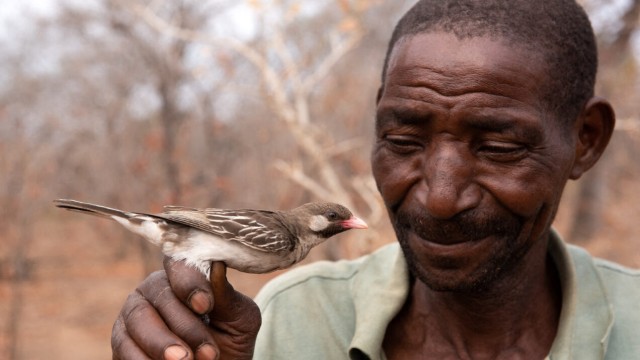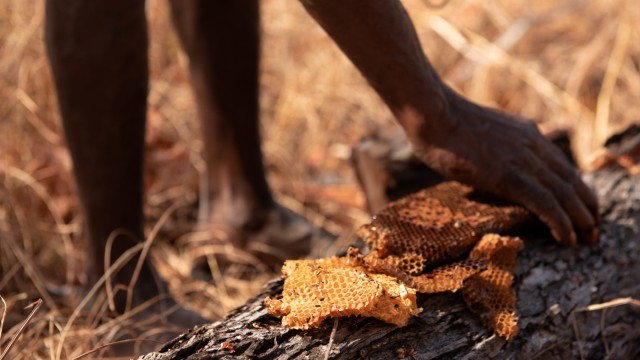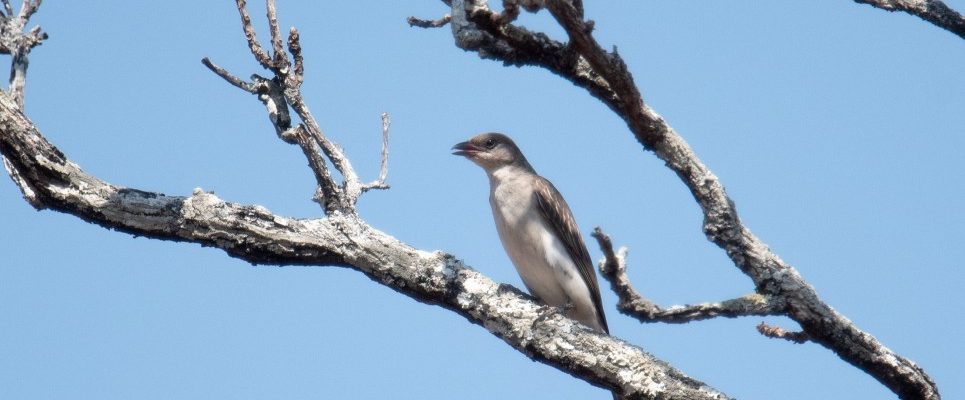When the Yao people in Mozambique crave something sweet, they don’t buy a chocolate bar or gummy bear. They attract a honey indicator. The approximately twenty centimeter tall, brown and white bird then leads them to a nest with wild bees, from which the Yao then harvest the sweet honey. The birds don’t do this out of love for people, they benefit from this cooperation: by harvesting honey, people give them access to the bees’ nest, which is often well protected in a tree hollow. Alone, the honey hunters, who don’t like honey at all, would never get their hands on their favorite food: beeswax and bee larvae.
Yao Honey Hunter Carvalho Issa Nanguar opens a bee’s nest with an axe. The smoke is supposed to drive away the bees
(Photo: Claire Spottiswoode)
A study that is currently in the science journal Science has appeared, has now shown that this unusual collaboration between birds and humans probably arose through a special kind of evolution in which both species influenced and learned from each other. Biologists speak of “cultural coevolution.”
To find out, the researchers used the phenomenon that people not only came up with the idea of working with honey indicators in Mozambique, but also in other African countries. However, there are big differences in the way the birds are attracted. The Yao people of Mozambique make a kind of trill-grunt that sounds like “Brrrr…hmm.” The Hadza in Tanzania, on the other hand, whistle to attract the attention of honey indicators.
In Brazil, dolphins help people catch fish
In her experiment, ornithologist Claire Spottiswoode from the British University of Cambridge walked with anthropologist Brian Wood from the University of California through the Kidero Hills in Tanzania, where the Hadza live. During their tour, the researchers played the whistle of the Hadza, the call of the Yao and recordings of people calling each other by name to the honey indicators and observed the birds’ reactions. They repeated the same thing in the Niassa Special Reserve, a large nature reserve in Mozambique where the Yao people live.

Yao honey hunter Seliano Rucunua holds a female honey pointer in Niassa Reserve, Mozambique.
(Photo: CLAIRE SPOTTISWOODE/AFP)
The birds’ reactions were extremely varied. In Tanzania, honey-gazers flew in three times more often when they heard the familiar whistle of the Hadza than when they were played the trill-grunt of the Yao. The shouts of people calling each other’s names served as a control. The birds did not respond to her any more than they did to the Yao call. In Mozambique it was exactly the opposite: the Yao’s “Brrrr….hmm” attracted the birds there twice as effectively as the Hadza’s whistle or the control voices.
The most likely explanation for this is that “the birds learn to respond to the signals of their local partners,” says Claire Spottiswoode in a statement from the University of Cambridge. According to the researchers, this is also supported by the fact that the genome of the honey indicators in Mozambique does not differ in any way from that of the birds in Tanzania. The different preferences for certain sounds cannot be inherited.

The wax from the honeycomb is intended for the helpful birds.
(Photo: Claire Spottiswoode)
Actually, it’s just like people who communicate with each other in different languages, says Spottiswoode. “People in different regions of Africa communicate with honey indicators using various local sounds.”
It is very rare for wild animals to cooperate with humans. Another example is dolphins, who help fishermen in the southern Brazilian city of Laguna catch mullet. The dolphins herd the fish together and then signal the fishermen where to cast their nets. What do the animals get out of it? That is still unclear. However, it has been shown that dolphins that cooperate have a 13 percent higher survival rate than dolphins that do not cooperate with humans.

